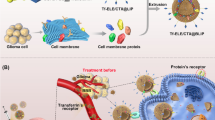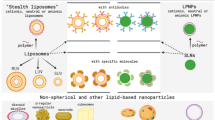Abstract
Invasive brain glioma is the most lethal type of cancer with highly infiltrating nature. It leads to an extremely poor prognosis and makes complete surgical removal of the tumor virtually impossible. Paclitaxel shows antitumor activities against invasive gliomas. However, the efficacy of paclitaxel against gliomas is limited by its poor solubility, non-penetration across the blood-brain barrier (BBB), and the resistance of brain glioma cells. A single medication cannot obtain optimal efficacy, while a combinational drug therapy may overcome this issue. This report focuses on liposomal formulations by incorporating paclitaxel and artemether and describes the preparation and characterizations of multifunctional paclitaxel liposomes, which are designed to treat brain glioma along with eliminating the cancer stem cells. In this liposomal drug delivery system, paclitaxel is used as the anticancer drug and artemether is used as the regulator; two functional materials (MAN-TPGS1000 and DQA-PEG2000-DSPE) are synthesized and used as functional materials by modifying onto the surface of the liposomes; egg phosphatidylcholine (EPC) and cholesterol are used as liposomal materials. The multifunctional paclitaxel liposomes, prepared by thin-film hydration, are about 80 nm, nearly electrically neutral and round with relatively smooth surfaces. The encapsulation efficiencies of paclitaxel or artemether are >80%. The multifunctional paclitaxel liposomes exhibit long circulation time, strong ability of transporting across BBB, and strong inhibitory effect in the brain glioma-bearing rats.
Similar content being viewed by others
References
Ai B, Bie Z, Zhang S, Li A (2016) Paclitaxel targets VEGF-mediated angiogenesis in ovarian cancer treatment. Am J Cancer Res 6(8):1624–1635
Anfosso L, Efferth T, Albini A, Pfeffer U (2006) Microarray expression profiles of angiogenesis-related genes predict tumor cell response to artemisinins. Pharmacogenomics J 6:269–278
Floyd JA, Galperin A, Ratner BD (2015) Drug encapsulated polymeric microspheres for intracranial tumor therapy: a review of the literature. Adv Drug Deliv Rev 91:23–37
Hien TT, White NJ (1993) Qinghaosu. Lancet 341:603–608
Nakase I, Lai H, Singh NP, Sasaki T (2008) Anticancer properties of artemisinin derivatives and their targeted delivery by transferrin conjugation. Int J Pharm 345:28–33
Postma TJ, Heimans JJ, Luykx SA, Groeningen CJ, Beenen LF, Hoekstra OS, Taphoorn MJ, Zonnenberg BA, Klein M, Vermorken JB (2000) A phase II study of paclitaxel in chemonaïve patients with recurrent high-grade glioma. Ann Oncol 11:409–413
Wang Y, Gao S, Ye WH, Yoon HS, Yang YY (2006) Co-delivery of drugs and DNA from cationic core-shell nanoparticles self-assembled from a biodegradable copolymer. Nat Mater 5(10):791–796
Wartenberg M, Wolf S, Budde P, Grünheck F, Acker H, Hescheler J, Wartenberg G, Sauer H (2003) The antimalaria agent artemisinin exerts antiangiogenic effects in mouse embryonic stem cell-derived embryoid bodies. Lab Invest 83:1647–1655
Wiradharma N, Tong YW, Yang YY (2009) Self-assembled oligopeptide nanostructures for co-delivery of drug and gene with synergistic therapeutic effect. Biomaterials 30(17):3100–3109
Yao HJ, Ju RJ, Wang XX, Zhang Y, Li RJ, Yu Y, Zhang L, Lu WL (2011) The antitumor efficacy of functional paclitaxel nanomicelles in treating resistant breast cancers by oral delivery. Biomaterials 32:3285–3302
Ying X, Wen H, Lu WL, Du J, Guo J, Tian W et al (2010) Dual-targeting daunorubicin liposomes improve the therapeutic efficacy of brain glioma in animals. J Control Release 141:183–192
Zhan C, Gu B, Xie C, Li J, Liu Y, Lu W (2010) Cyclic RGD conjugated poly(ethylene glycol)-co-poly(lactic acid) micelle enhances paclitaxel anti-glioblastoma effect. J Control Release 143:136–142
Zhang L, Yao HJ, Yu Y, Zhang Y, Li RJ, Ju RJ et al (2012) Mitochondrial targeting liposomes incorporating daunorubicin and quinacrine for treatment of relapsed breast cancer arising from cancer stem cells. Biomaterials 33:565–582
Author information
Authors and Affiliations
Corresponding author
Editor information
Editors and Affiliations
Rights and permissions
Copyright information
© 2021 Springer Nature Singapore Pte Ltd.
About this entry
Cite this entry
Li, XY. (2021). Preparation of Multifunctional Paclitaxel Liposomes for Treatment of Brain Glioma. In: Lu, WL., Qi, XR. (eds) Liposome-Based Drug Delivery Systems. Biomaterial Engineering. Springer, Berlin, Heidelberg. https://doi.org/10.1007/978-3-662-49320-5_9
Download citation
DOI: https://doi.org/10.1007/978-3-662-49320-5_9
Published:
Publisher Name: Springer, Berlin, Heidelberg
Print ISBN: 978-3-662-49318-2
Online ISBN: 978-3-662-49320-5
eBook Packages: Chemistry and Materials ScienceReference Module Physical and Materials ScienceReference Module Chemistry, Materials and Physics




